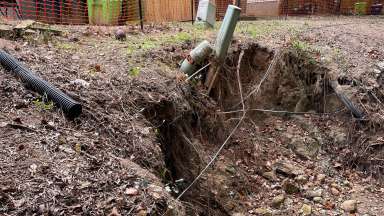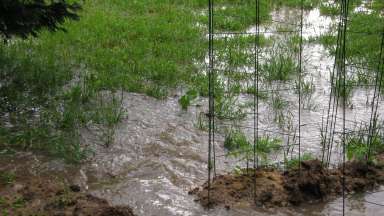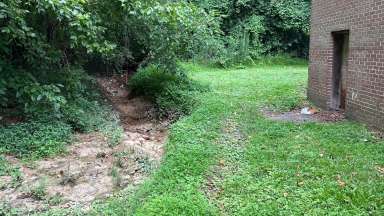Jump To:
Plan Review
Plan reviews for stormwater requirements are done with:
- Administrative Site Review and Site Permit Review
- Subdivision Cases
- Residential Plans including new Single-family dwellings, deck, accessory structures etc.
- Mass grading only permits
- Recorded Map Cases
Flood Permits
All work in or near a designated flood hazard area requires a flood permit. Once a permit is obtained, the construction inspector checks the site for installation of benchmarks and, upon completion, ensures that work is conducted based on what is approved in the permit. The inspector also ensures that all necessary elevation certificates, FEMA or City, are completed for the activity.
Working in the Neuse River
The Neuse River Buffer is measured 50 feet from the top of the bank on both sides of a stream or 50 feet from the average high water level of surface waters.
If activities are proposed within this buffer then the North Carolina Division of Water Resources (DWR) should be consulted and permits may be required.
If a project is located adjacent to a Neuse River Buffer the City of Raleigh will often require a Watercourse Buffer Permit. When a buffer permit is issued by the City of Raleigh, the construction inspector will ensure that all watercourse buffers on the property are properly flagged and that prohibited activities do not occur in the buffer. If unauthorized work occurs in the buffer, DWR will be notified if enforcement is required.
Watershed Protection
You must have special requirements if building in these protected areas:
- Upper Neuse River/Richland Creek;
- Falls Lake; and,
- Swift Creek.
Watershed restrictions include utilizing measures to treat stormwater and limiting the amount of hard impervious surfaces such as buildings, driveways, and sidewalks.
Plan Review assesses plans for development within these districts for compliance with Article 9.5 of the City of Raleigh Unified Development Ordinance (UDO).
Development activities, including minor improvements, within the Watershed Protection Overlay District are required to obtain a Watershed Permit. When a stormwater project is completed, the construction inspector ensures that necessary as-built surveys are submitted, stormwater devices are installed, and/or impervious surface limits are not exceeded.
Land Disturbance Permit
To limit sediment from entering waterways, Article 9.4 of the City of Raleigh UDO requires any land-disturbing activity that is 12,000 square feet or more in size to have a land disturbance permit prior to the start of any construction activity.
To obtain a land disturbance permit, an erosion and sediment control plan must be submitted and reviewed for compliance with City and State erosion and sediment control guidelines. Plan Review assesses the erosion and sediment control plans as part of the Mass Grading Only and Site Permit Review processes and issues the land disturbance permit.
Once the permit is issued, the construction inspector will inspect the site on a regular basis to ensure the sediment and erosion control devices are in compliance with the approved plan and in proper working condition. Inspection of the site will continue until all work is complete and the site is stabilized.
If the area of land disturbance is one acre or more in size, the NC Division of Energy, Mineral and Land Resources requires that the individuals responsible for the land-disturbing activity must obtain an NPDES Construction Permit from the state of NC.
These records are required from the start of construction to completion of the project.
Single Family Erosion Control
A land disturbance permit is not required when building a single family home with less than 12,000 square feet of land disturbance. However, installation of erosion control measures is required for all single family lots regardless of size of disturbance. At a minimum, required measures include:
- A construction entrance utilizing two to three inch stone that measures 30 feet deep by 10 feet wide;
- Silt fence installed on low ends of the site and back of curb to ensure utilization of construction entrance.
An inspector will typically conduct an inspection once the footers are poured to ensure that erosion control measures are installed and maintained.
Construction Stormwater General Permit
Are you working on a project that disturbs one acre or more of land? You will need to apply for a construction stormwater general permit online with NCDEQ (effective April 1, 2019).
We will continue to approve erosion and sediment control plans. We also will continue to issue grading permits.
Here’s what you need to know:
- We will no longer issue NCG01 permits with our grading permit. You will need to submit a Notice of Intent for the general construction permit online.
- Remember to include two new NCG01 plan sheets with your mass grading or concurrent review.
- You’ll need to use these new plan sheets if you have a plan under review or if you submitted a plan after April 1. Permits must include:
- Grading permit issue date and number;
- Name of the approving local program (i.e. City of Raleigh); and,
- Official permit card.
- There is a $100 annual fee from NCDEQ for this permit beginning in May. Projects with an approved grading permit will automatically follow the new NCG01 permit. But, you will not need a Notice of Intent or to pay an annual permit fee. Please have the permit and two standard plan sheets displayed on your construction site.
- After your final grading permit inspection is approved:
- Close out the NCG01 permit;
- Submit a Notice of Termination to NCDEQ; and,
- Provide a copy of your Certificate of Completion to NCDEQ.
Stormwater Devices
Plan reviewers look at:
- Stormwater and drainage plans as part of a preliminary subdivision and site plan review;
- Peak runoff calculations for pre-development and post-development conditions;
- Proposed stormwater device designs and detention calculations submitted with preliminary subdivision and site plans;
- Infrastructure construction plans; and,
- Plans and calculations submitted for permitting.



